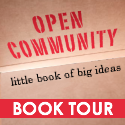 We come from the association industry and for many of us “membership” people, community is old hat. It’s what we do. It’s central to our work. And yet, for some reason (actually a lot of reasons) what we know about community isn’t always translating well to building community online. Maddie and I have talked to thousands of association executives who have voiced their frustrations about the social web--from the overabundance of tools and the disorderly experimentation of staff and members, to the lack of organizational support and the unwieldy processes for monitoring and managing social media, and that’s just the beginning.
We come from the association industry and for many of us “membership” people, community is old hat. It’s what we do. It’s central to our work. And yet, for some reason (actually a lot of reasons) what we know about community isn’t always translating well to building community online. Maddie and I have talked to thousands of association executives who have voiced their frustrations about the social web--from the overabundance of tools and the disorderly experimentation of staff and members, to the lack of organizational support and the unwieldy processes for monitoring and managing social media, and that’s just the beginning.
It’s easy to get bogged down in the newness and the detail, and miss the bigger picture--not the 10,000-foot bigger picture, but the "just high enough to make practical sense” bigger picture. 
So we started writing the book, and the idea that kept popping up is the concept of Open Community. Here’s the gist... Your Open Community is your people who are bonded by what your organization represents and care enough to talk to each other (hopefully about you!) online. To be clear, the Open Community concept is not about building an online community platform or internal, private social network. That could be one tactic in your arsenal, but one of the most important first steps toward building community online is accepting that your Open Community is out there, not just on your web site. Your stakeholders are connecting on their own terms in the social spaces where they spend the most time, and you need to be where they are. Sometimes, rather than hosting every conversation and leading every initiative, your organization can (and should) be simply present as a supportive participant.
For charitable nonprofits and foundations, connecting and bonding with your Open Community is the difference between running a good one-off campaign, or creating an ongoing movement where you can tap into your community when you need them most. We’ve seen membership organizations spark up great advocacy or fundraising efforts, but without the organization’s ongoing commitment to nurture the community, the fire goes out. Open Community is about building the capacity to continuallybuild and connect with your Open Community so that you can keep the fire going. And when the time comes for the big push, you just need to add extra fuel to that fire.
We hope the book will help Frogloop readers get a good understanding of how to embrace the Open Communities around their organizations - to engage them in the right way so that the full power of social media can be unleashed when you need it most. We would love you to share examples of any nonprofits doing this well!
This post in part of the virtual book tour Maddie Grant and Lindy Dreyer are doing to explore concepts from their new book Open Community: A little book of big ideas for associations navigating the social web. This post is Lindy’s take on the Open Community concept and why it’s important.



COMMENTS